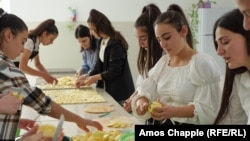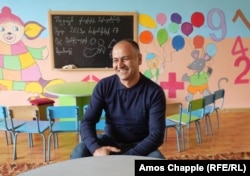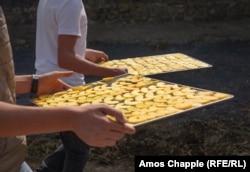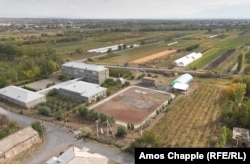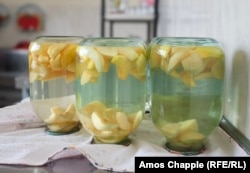AMBERD, Armenia -- When a student failed to show up to class one day in early 2012, school principal Zohrab Maghakian called the boy’s home to find out why.
The parents of the missing student confided that they couldn’t afford to buy their son a uniform, so he stayed home.
“I felt terrible,” Maghakian recalls of the phone call, made shortly after he started as principal of the school. “It was impossible to block out the thought that a child was unable to come to class for this reason.”
Soon afterward, the young director set about transforming the school into an operation that could support its neediest students, while teaching them the lessons of village agriculture.
Today, the H. Navasardian Secondary School, located about an hour’s drive west of Yerevan, buzzes with activity between classes. In one room, girls and teachers sing traditional songs as they slice apples and peaches into slivers that boys carry to drying machines.
Outside, boys use shovels to channel water through groves of plum trees. The school also has apricot trees, rows of strawberry bushes inside a greenhouse, potatoes, and a large vineyard. In a nearby mountain village, the school’s beehives will soon be returned to the school grounds for the winter.
Much of the resulting annual harvests, which include tons of fresh grapes, scores of kilograms of honey, and vast amounts of dried fruit, is eaten by students. But the bulk is sold to local villagers, many of whom on-sell the produce to fruit-processing factories.
From this income, the school is able to clothe some students and feed almost all 250 of them.
“In Armenia, school lunches are paid for by the government up until the fourth grade. Here, we are able to feed them until the ninth grade,” Maghakian says, noting that the state budget is just 151 Armenian drams ($0.38) per student per meal.
For students in need of clothing, lengths of fabric are purchased, then teachers skilled in sewing produce the school uniforms to order. Maghakian claims the labor is done outside of classroom hours and does not interfere with the students’ traditional lessons, but the school has applied to have one hour per day of agricultural work included in its curriculum.
The food production has its own educational value, Maghakian says, because not all students will end up in university, and all see the tangible results of physical work.
Student Diana Karapetian says the skills she learned at the school have given her the ability to help her mother at home, particularly by drying fruit to last through winter.
“I do the work with pleasure here at the school, because we’re all together," she says. "We bond like this.”
An old poplar tree in the schoolyard had to be cut down recently. With the help of local craftsmen, the students were able to fashion a large picnic table out of the tree’s timber, which sold for 150,000 drams ($370).
Maghakian told RFE/RL that his school has been largely left alone to develop the unusual funding model without problems from state bureaucrats. He hopes other schools will be able to follow Amberd’s lead.
“We can see that our country has serious problems. Why should schools constantly be going and asking for extra money from the government? Our school needs funding for a new wall now, but we will be able to raise this money," he says. "We can help our country by helping ourselves."
